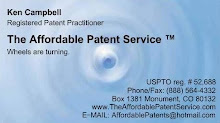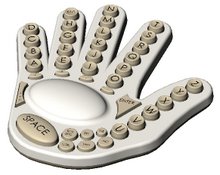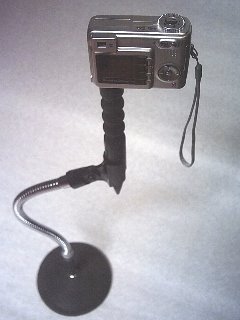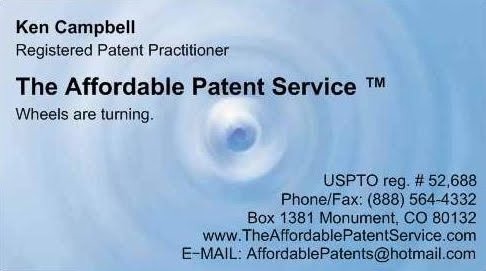Sunday, August 31, 2008
Monday, June 30, 2008
Saturday, May 31, 2008
Consider an Accelerated Examination...or Not
Typically, the examination process for a utility patent application is between 2 to 5 years. (Don't shoot the messenger.) But, there are ways to accelerate that process. A "petition-to-make-special" is one of those ways. Though, it can come at a price to the inventor. In fact, only if the applicant is at least 65 years of age can an application be expedited at no additional cost or effort, through a petition to make special (PTMS). If the applicant's health is poor, however, a PTMS can be submitted along with a showing of evidence that the applicant is indeed in poor health, which can involve much more preparation.
Now, there are still other reasons that the USPTO will accept, in granting an accelerated examination of a patent application. If an inventor has a project that significantly protects/improves the environment or society (in general terms), saves energy, or advances certain fields of science, then the patent application may qualify for expedition. In such cases, a PTMS can be filed. If the inventor feels the project is in jeopardy because of existing infringement, or because a manufacture may only be available temporarily, then a PTMS may also be filed. But, in any of these cases (except for applicants of poor health, or of age 65) the results of a fairly comprehensive international patent search must be submitted with a petition. This adds to the expense of the application, whether the search is conducted professionally, or by the inventor.
These requirements are relatively new. And, many now feel that they put an undue burden on the inventor, especially if the USPTO creates its own backlog. And, when it comes to expediting the examination process, some believe that age and poor health give the only practical advantage. Incidently, where there are two or more co-inventors of a particular project, only one of them needs to qualify...
Now, there are still other reasons that the USPTO will accept, in granting an accelerated examination of a patent application. If an inventor has a project that significantly protects/improves the environment or society (in general terms), saves energy, or advances certain fields of science, then the patent application may qualify for expedition. In such cases, a PTMS can be filed. If the inventor feels the project is in jeopardy because of existing infringement, or because a manufacture may only be available temporarily, then a PTMS may also be filed. But, in any of these cases (except for applicants of poor health, or of age 65) the results of a fairly comprehensive international patent search must be submitted with a petition. This adds to the expense of the application, whether the search is conducted professionally, or by the inventor.
These requirements are relatively new. And, many now feel that they put an undue burden on the inventor, especially if the USPTO creates its own backlog. And, when it comes to expediting the examination process, some believe that age and poor health give the only practical advantage. Incidently, where there are two or more co-inventors of a particular project, only one of them needs to qualify...
Wednesday, April 30, 2008
Monday, March 31, 2008
Just the Tax, Ma'am...
As you might expect, the cost for filing a US patent application can be currently deducted from your taxable income. In other words, it can be used as a business write-off for a single tax year. The main requirement is that you must go about your project, from early on, as if you intend to profit from it eventually. Simply put, you have to think of it as a business. This means you should track income and expenses routinely. You should also log the time you spend doing anything to sustain the livelihood of the business project, itself.
You will be writing-off all of your patent application expenses as Research and Experimentation for your invention-based business. Those expenses can include additional research, engineering and prototyping. The Affordable Patent Service can itemize, document, and conduct these other activities for you, as well.
You don’t need to show (or even expect) very much income in the first few years, necessarily, to maintain a business status with your project. But, as much as inventing can be an enjoyable hobby, it is important to treat your activities responsibly, when it comes to money, time, diligence, and so on. This will show that you are handling your efforts like a business. Doing so will actually promote good habits for documenting your invention developments.
The simplest way to track your development is with some sort of timesheet. (A good one to use is the Year-at-a-Glance, which lets you log hours either by day or by month.) A supplemental form of documentation is the APS Provisional Disclosure. There are also some very handy and inexpensive computer programs made for “clocking in” to your project(s). You should get into a routine of logging hours for all of your project activities, which may include acquisitions, prototyping, research, networking, milestones, and fund-seeking. Records for the involvement of such things need to be well-kept in order to establish a business-like approach, and before considering yourself entitled to deduct or depreciate anything as a business expense.
 In terms of finances, it is often suggested that setting up a separate bank account, and dedicating it to only project transactions is just about the most convenient way to track business income and expenses. If the project can be included as part of a larger group of projects or a business venture, then that’s fine too. It’s essential, though, to demonstrate individual focus with each of them. You want your efforts to look like more than just a plain old hobby. Adopting a business-like approach to your project finances goes a long way in achieving appropriate status, with respect to taxes. And, taking steps to acquire intellectual property is a great way to demonstrate to the IRS that you mean business.
In terms of finances, it is often suggested that setting up a separate bank account, and dedicating it to only project transactions is just about the most convenient way to track business income and expenses. If the project can be included as part of a larger group of projects or a business venture, then that’s fine too. It’s essential, though, to demonstrate individual focus with each of them. You want your efforts to look like more than just a plain old hobby. Adopting a business-like approach to your project finances goes a long way in achieving appropriate status, with respect to taxes. And, taking steps to acquire intellectual property is a great way to demonstrate to the IRS that you mean business.
Incidentally, if things don’t go as well as expected with your project, it is also possible to donate your application, or issued patent, to a non-profit organization. This allows you to write-off the fair market value of the intellectual property, in the tax year following your donation. Look for a coming article for more information about that…
You will be writing-off all of your patent application expenses as Research and Experimentation for your invention-based business. Those expenses can include additional research, engineering and prototyping. The Affordable Patent Service can itemize, document, and conduct these other activities for you, as well.
You don’t need to show (or even expect) very much income in the first few years, necessarily, to maintain a business status with your project. But, as much as inventing can be an enjoyable hobby, it is important to treat your activities responsibly, when it comes to money, time, diligence, and so on. This will show that you are handling your efforts like a business. Doing so will actually promote good habits for documenting your invention developments.
The simplest way to track your development is with some sort of timesheet. (A good one to use is the Year-at-a-Glance, which lets you log hours either by day or by month.) A supplemental form of documentation is the APS Provisional Disclosure. There are also some very handy and inexpensive computer programs made for “clocking in” to your project(s). You should get into a routine of logging hours for all of your project activities, which may include acquisitions, prototyping, research, networking, milestones, and fund-seeking. Records for the involvement of such things need to be well-kept in order to establish a business-like approach, and before considering yourself entitled to deduct or depreciate anything as a business expense.
 In terms of finances, it is often suggested that setting up a separate bank account, and dedicating it to only project transactions is just about the most convenient way to track business income and expenses. If the project can be included as part of a larger group of projects or a business venture, then that’s fine too. It’s essential, though, to demonstrate individual focus with each of them. You want your efforts to look like more than just a plain old hobby. Adopting a business-like approach to your project finances goes a long way in achieving appropriate status, with respect to taxes. And, taking steps to acquire intellectual property is a great way to demonstrate to the IRS that you mean business.
In terms of finances, it is often suggested that setting up a separate bank account, and dedicating it to only project transactions is just about the most convenient way to track business income and expenses. If the project can be included as part of a larger group of projects or a business venture, then that’s fine too. It’s essential, though, to demonstrate individual focus with each of them. You want your efforts to look like more than just a plain old hobby. Adopting a business-like approach to your project finances goes a long way in achieving appropriate status, with respect to taxes. And, taking steps to acquire intellectual property is a great way to demonstrate to the IRS that you mean business.Incidentally, if things don’t go as well as expected with your project, it is also possible to donate your application, or issued patent, to a non-profit organization. This allows you to write-off the fair market value of the intellectual property, in the tax year following your donation. Look for a coming article for more information about that…
Friday, February 29, 2008
INSTRUCTABLES: The Origin of Scrupulous
Above is my avatar at Instructables.com, one of the more interesting websites out there, for building stuff. Click on the image to check out my first project at the site. There's also a pretty active forum section, too. Just make sure to bring your hardhat...
Thursday, January 31, 2008
INVENTION FLOWCHART: Courtesy of APS ™

This is the new home of a simple visual aid to guide you along the invention process from start to finish. Keep in mind, it may not be the same finish for every one. But if you have an idea, and your not quite sure where to start, then go to the lower left of this image and work your way through the flowchart...
Subscribe to:
Posts (Atom)








